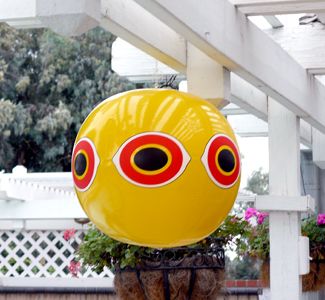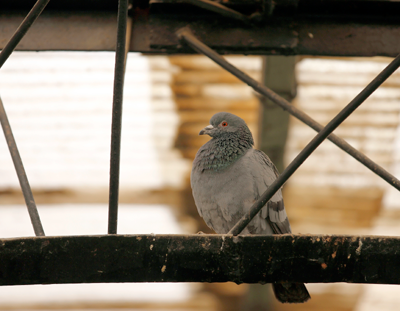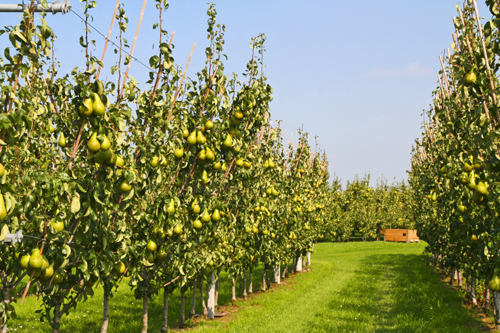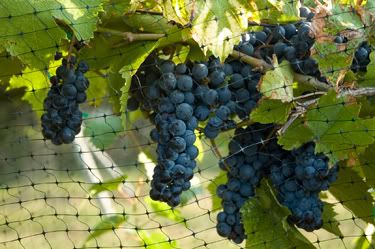
by Alex A. Kecskes
Pest birds have pooped all over your new statue. They've covered your sign with "dried mayo," and someone has threatened to sue you for slipping on bird poop as they entered your property. You've had it with the invasion of these fine-feathered "friends." You're ready to stick your head out of your window and yell, "I'm mad as hell and I'm not going to take it anymore!"
Relax. There are many ways to scare birds away. And keep them away. Without resorting to poisons or firearms. They run the gamut from economical to high-tech. Most can be used in any location or circumstance. Best of all, they're humane and effective in discouraging a wide range of pest birds from landing, pooping and nesting on your property.
Since the economy is in a downturn, we'll start with the simplest, most economical bird guard--the Bird Scare Products. These "shoo" birds away by capitalizing on their fear of shiny things that jostle in the wind. They include iridescent reflective foil or flash tape, scare balloons, banners and the like that serve to create an “Optical Distraction Zone” for most pest birds. Some bird scare balloon chasers have giant eyes that look predatory and threatening. All are easy to install and won't harm birds. They're ideal for gazebos, overhangs, patios, vineyards, parks, pool and spa areas, boat docks and other open areas.
The Bird Diverter, uses scare-eye images to deter pest birds. Like the chaser, they're simple to install and surprisingly effective. Some bird diverters serve double duty, with iridescent foil eyes to scare birds by day and glow-in-the-dark on the flip side to shoo them away when it gets dark.
Last but not least are the higher tech solutions, bird deterrents that scare birds using sound.
When it comes to sound, today's sound bird deterrents can be quite effective. Some audio bird guards create shrill predator and bird distress calls to scare birds away. Others just produce annoying sounds that drive birds away. All are ideal for enclosed areas like parking garages, sheds and overhangs to deter a wide range of pest birds, including sparrows, starlings, pigeons, seagulls and larger birds.
So, if you're troubled by pest birds, you don't have to take it any more!

by Alex A. Kecskes
Tired of hosing off bird droppings from your car/SUV/camper or boat? Have you run out of car soap in scrubbing off bird poop? Unless you’ve implemented effective bird control measures to keep pest birds off your vehicles and boat, these acidic droppings will eat into the paint and cause permanent damage. So you’re more or less stuck whipping out your hose and sponges every day, cleaning off those smelly droppings—droppings that can carry any of 60 known diseases.
Bird droppings damage paint when the cooling paint lacquer contracts and hardens around their deposits. When exposed to sunlight, bird droppings dry and harden. At the same time, paint lacquer heats up in sunlight, causing it to soften and expand. When the paint lacquer cools down at night, it contracts and hardens around bird droppings. Left for any length of time, the droppings will eventually etch the paint.
Some vehicle and boat owners have resorted to canvas covers. But these, too, must be cleaned often or the bird droppings will harden, weaken the fabric and cause it to rip and tear. Vehicle covers, especially boat covers, are not cheap.
Fortunately, there are a number of bird deterrents you can use to keep pest birds off your vehicles and boats parked in your driveway. The two most popular bird control measures include:
Sonic Bird Deterrents
While they may not have raebbit ears, birds have very acute hearing. They’re always on the alert for a fellow bird in distress or the threatening shriek of an approaching predator. Sonic Bird Deterrents deliver the message, broadcasting recorded distress and predator calls that make birds far too nervous to stay around your driveway. The sounds they emit resemble normal bird sounds to humans, so you don’t have to worry about neighbors complaining or your dog or car rushing for cover. The best sonic deterrents will be versatile enough to emit a number of sounds. One sonic bird deterrent currently available can generate distress and predator calls for 22 different species of birds. It’s basically “dial sound” and forget about pest birds. Look for sonic deterrents that feature a built-in speaker, a volume control, and one that lets you program it to turn on or off at night.
Bird Scare Deterrents
If you’re on a budget, these versatile bird deterrents will keep pest birds away from your vehicle or boat. They include inflatable balloons--covered with predator eyes—that sway in the breeze to convince pest birds there’s a big predator just aching to eat them. Scare eye diverters are similar to balloons in that they feature a big eye that spooks birds even thinking about landing on your car or boat. For best effect, you would typically hang these deterrents from your garage (for cars/SUVs), or tied to your covered boat or camper. Just make sure you move them about from time to time or birds will get wise to them.

Birds can be a costly nuisance around boats and marinas. When they perch and roost on seaside structures, bird droppings can deface and damage signs, windows, rooftop HVAC units and rain gutters. Docks, railings, walkways, boat houses, pilings and swim platforms can quickly become inundated with bird droppings, leaving an unsightly mess that can create a slip-and-fall hazard. Large birds like gulls, geese, ducks and cormorants can “unload” sizable droppings that require frequent and costly cleanups.
Without effective bird control, boat owners and boat rental outfits need to constantly clean their boats of droppings. Left to accumulate, these droppings can damage boat covers, spreaders, window gaskets, sails, outboard engines, sliding doors, deck surfaces and antenna arrays.
Both boat owners and seaside businesses need to be proactive when it comes to bird deterrents. Achieving effective bird control calls for proven devices that deter birds humanely and keep them away. Here are some devices you should consider to keep pest birds away from your boat or marina business:
The Repeller 360
Using a large, wind-powered sweeping arm, The Repeller 360 is designed to keep large birds like pigeons, crows, gulls, cormorants and raptors away from both boats and marina structures. The Repeller 360° is “armed” with large, reflective “predator eyes” that add to its threatening appearance and function. The device is easy to set up on virtually any flat surface. Rotating continuously in the slightest breeze, The Repeller 360 covers a full 6-foot diameter to keep birds away.
Bird Spiders
Also wind powered and quite effective, Bird Spiders feature wildly flailing arms that whip about in the breeze to frighten birds away. A few bird spiders placed strategically on rooftops, canvas covers and boat decks will cause gulls, cormorants, pelicans and pigeons to simply move on. Bird spiders come in 2-, 4-, 6- and 8-foot diameter arm lengths to create wider and wider circles of deterrence. The best bird spiders are made in the USA and feature a glue-on base for effortless mounting. These spiders will also have a UV-protected polycarbonate base for lasting durability in harsh water-front weather. Removable sand bag bases are also available, which let you set bird spiders up virtually anywhere. Additional mounting bases allow for easy placement on masts and radar units.
Stainless Steel Bird Spikes
Used by boat owners and marinas worldwide, Stainless Steel Bird Spikes provide anti-perching, ant-roosting protection for rooflines, parapet walls, signage and other lofty areas. Installed on boats,they prevent birds from landing on masts, rooftops, and areas around antenna systems. The most rugged and seaworthy bird spikes are made in the USA of stainless steel, with pins embedded in a UV-protected polycarbonate base. These spikes are guaranteed for 10 years. The spikes come in 1”, 3”, 5” and 8” widths and have a 1.5” base, which allows you to mount the spikes on very narrow surfaces. The best spikes also have a built-in a glue trough and feature pre-drilled mounting holes for fast, easy installation.

by Alex Kecskes
If your home has a separate garage or shed, you probably have pest birds roosting and nesting either inside or under the eaves. Birds love to perch on the rooftops and exposed beams of these structures. And unless you deter them with some bird control device, birds will continue to gather in greater numbers in and around these structures. Eventually, birds will even start to nest and roost under the eaves of your home.
The longer you wait to implement some effective bird control measures, the more brazen the birds will become. They’ll start to gather in your back yard and leave droppings all over your pool, spa, patio, and BBQ. Keep in mind that birds can carry any of 60 known diseases. If you have children or pets, you’ll be cleaning up the bird droppings on a daily basis.
The good news is that there are a number of humane and effective bird deterrents that you can use. Here are a few that you should look into:
Garden Bird Netting
Lightweight and easy to handle, Garden Mesh Netting will block birds from specific nesting sites around your shed or garage. It comes in 14 x 100-foot and 14 x 200-foot rolls, but you can easily cut it down to the size. It’s also available in three different "mesh" sizes--1/4" mesh, 1/2" mesh and 3/4" mesh. It’s easy to install under eaves and other areas, especially if you use the bird netting clips that are recommended. The netting is made from a durable, UV-protected polypropylene. It’s strong, lightweight and virtually invisible.
Bird Slope
Scientifically designed to keep pest birds away from eaves and similar nooks and crannies, Bird Slope are slippery PVC panels that mount under eaves to prevent birds from gaining a foothold. They scramble and “squirrel-cage” with their little toes and finally give up, moving on to other more hospitable areas. The best bird slope panels are UV protected and sun- and weather-resistant to last longer. Bird slope is ideal for deterring a wide range of birds—including swallows, starlings, pigeons and seagulls. The panels blend in with most architectural styles and they’re now available in two colors--stone and grey.
Copper Stuf-Fit Mesh
Ideal for keeping pest birds out of small holes and crevices, Copper Stuf-Fit mesh creates a physical barrier that blocks out birds. It’s ideal for use in openings and tight spaces too small for regular netting or other products. The mesh comes in 20-foot and 100-foot roles and can be “formed” into the shape of the area needed to deny birds access. The wire mesh will hold its shape in tight areas to prevent birds from “working” their way around it. It can also be used to block birds from getting under roofing tiles, retractable awnings, and where pipes enter siding or foundations.
No Nasty Nest
Ideal for use in blocking swallows, No Nasty Nest consists of hanging "twine" that denies birds access to nesting sites. Faced with wading through the twine strips, birds will simply move on to a better spot to nest. If you have swallow mud nests under the eaves and sides of your garage, shed or home, you’ll want to get this bird deterrent. Each strip of No Nasty Nest has a self-adhering back for fast application on eaves, gables, entryways and other areas.

by Alex A. Kecskes
A beautiful garden can be a joy to behold. It reflects the hours of work and care you put into it—the feeding and weeding and spraying for bugs. But unless you exercise some form of effective bird control, your well-tended garden can quickly be ruined by pest birds. Vegetable and fruit gardens are particularly vulnerable. While a few songbirds can add a certain ambiance to a garden, gathering flocks of birds—like crows, pigeons, finches—can destroy ripening fruit and vegetables. They can leave droppings everywhere, turning your garden into a smelly, disease-carrying mess.
The only way to protect your garden is with proven effective bird deterrents. And the best way to ensure your garden won’t be attacked by flocks of pest birds is to implement these bird deterrents before your fruits and vegetables ripen.
Here are three of today’s most popular and effective pest bird deterrents:
Plastic Bird Netting
Creating a physical barrier that denies birds access to specific areas of your garden, Plastic Bird Netting offers a humane, low profile bird deterrent. The netting usually comes in 14 x 100-foot and 14 x 200-foot rolls and three different mesh sizes. There’s a 1/4-inch mesh for smaller birds and a 1/2-inch mesh and a 3/4-inch mesh for larger birds. The best plastic bird netting is fabricated from durable, U.V.-protected polypropylene. This netting is strong, light, easy to handle and virtually invisible.
Install bird netting before your garden bears fruit or vegetables. Suspend the netting over your bushes or vines by at least 6 inches. Protect vegetables by wrapping individual plants in netting or suspend the netting around an entire garden area. To safeguard fruit trees, measure the circumference of the tree and cut the net to size (allow at least one foot extra around the circumference). Secure the netting with twine, zip ties, or hog rings.
Sonic Bird Deterrents
These devices broadcast bird distress and predator calls that make birds feel too uneasy to stay in your garden. The sounds resemble normal bird sounds, so they won’t irritate your pets, friends or neighbors. One highly versatile sonic system can emit distress and predator calls for 22 different species of birds. This unit covers up to an acre of land and can be programmed to turn on or off at night.
Visual Bird Deterrents
Ideally, you would want to use Visual Bird Deterrents in conjunction with the two deterrents mentioned above. These consist of Flash Tape and Reflective Banners, which reflect sunlight and snap in the breeze to make birds too nervous to feed. Also included in this category are Scare Eye Diverters and Bird Scare Balloons—both feature large predator eyes to intimidate pest birds. Visual bird deterrents attach easily to patio covers, gazebos, tree branches, or any elevated area in your garden. Just remember to move them around frequently to convince birds they are “live” threats.

by Alex A. Kecskes
As a homeowner, you know that pest birds can cause considerable damage to your garden. Fruits are especially vulnerable and can be quickly ruined by even a few birds.
Today, 95 percent of all American gardens grow tomatoes. One woman in North Texas suffered extensive damage to her tomato plants by mockingbirds. As soon as her tomatoes got red, ripe and ready to pick, the birds would take bites out of them. They would continue to nibble on her tomatoes all day long. A great-looking tomato, almost ready to pick in the morning, would be ruined with bite marks by late afternoon. Effective pest bird deterrents would have saved her tomatoes.
A sure sign that birds are attacking your fruit is the presence of holes throughout. Starlings and blackbirds can eat the fruits and vegetables you worked so hard to grow. Canada geese will munch on your grass and leave nearly a pound a day (per goose) of droppings. Birds can also damage your favorite trees. They’ll rip through bark searching for bugs. Few plants are safe from pest birds. They’ll use their beaks to rip, tear and tug your plants pieces.
The temptation is to resort to lethal bird control measures—like BB guns and poisons (avicides). But if you have pets or children, these methods are highly undesirable as well as being inhumane to birds. Fortunately, there are a number of bird deterrents on the market that are both effective and humane. They’re ideal for keeping pest birds out of your garden. Here are three proven bird control measures:
Lightweight Plastic Bird Netting
Plastic bird netting lets you exclude pest birds from garden, enclosed courtyard, patio or similar area. The netting comes in various mesh sizes to block out pigeons, sparrows, starlings, seagulls and other birds. The best high quality bird netting is available in various colors to blend in with your garden’s décor. One manufacturer offers a bird netting kit for fast, easy installation. The kits include perimeter cable, cable crimps, turnbuckles, intermediate attachments, hog rings, and accessories and tools.
Sonic Deterrents
These devices generate distress and predator calls that make birds too scared to hang around and feed. One commercially available system can generate such calls for 22 different species of birds. The calls, repeated every 10 minutes, resemble natural birdcalls to humans and won’t irritate pets. You can set a volume control to generate from 65-105 decibels, and you can program the unit to turn on or off at night. The best bird sonic units come with a built-in speaker that protects gardens up to an acre.
Bird Scare Deterrents
These inexpensive bird deterrents create an “Optical Distraction Zone” that makes pest birds too nervous to hang around your garden. They consist of reflective foils, shiny tape banners and balloons that are easy to install. Some balloons have giant predator eyes to give birds that “spied on” feeling. Balloons can also be filled partially with water to skim the surface of swimming pools, spas and Koi ponds.

by Alex A. Kecskes
If your home has been besieged by gulls, you know what a nuisance they can be. These scavengers will eat just about anything that’s on your patio, boat dock or backyard. That includes fish, insects, mollusks, worms, mice, young birds, bird eggs, and berries. When gulls feast and gather, they'll leave an awful mess. They can cover your backyard and patio area with smelly, disease carrying droppings and rotting fish. If they use your rooftop to tear apart their prey, they can dislodge and damage roofing tiles and other rooftop structures.
Like most birds, it’s not just one type of gull you have to worry about. There are over 45 species of gulls. Your typical gull is a medium to large bird with a mostly white body and grey or black markings on the wings and tail. Their stout, orange bills and webbed feet make them easily recognizable. While gulls are often found near large bodies of water like bays, inlets and lakes (as well as the ocean), they have been known to venture inland for food. So don’t be surprised to see them on the roof of your home or patio if your home is miles inland.
To keep gulls away from your home, you should first remove any open food source such as open trashcans or pet food. After that, you’ll need some effective bird control measures to keep them away. Here are three bird deterrents the pros use:
Bird Spikes for Gulls
Gulls regularly choose the roof of a home or structure to roost on. The peak of a roof is an especially desired area as it provides a nice look out point for food and predators. Bird Spikes are a humane product used to keep gulls off roof lines, parapet walls, pilings and other areas. Bird Spikes simply create an uneven surface that gulls know they cant land on. Spikes that are pre-assembled, such as the Stainless or Plastic versions are easiest to install.
Bird Spiders
Bird Spiders have spindly arms that whip about in the wind. Gulls see these and will simply move on to a friendlier landing perch. Bird Spiders are easy to set up on decks, posts, atop light fixtures, rooftops, fixed umbrellas and awnings. These bird deterrents are available in 2-, 4-, 6- and 8-foot arm lengths to create larger and larger areas of bird deterrence. Look for bird spiders that feature a glue-on base, which can be attached to most surfaces.
Sonic Gull Control
No gull likes to hear his fellow gulls being attacked. Or the sound of Peregrine falcons screeching in for the kill. Bird Sonic Deterrents exploit these fears and drive gulls away. These devices broadcast prerecorded distress and predator calls that resemble normal bird sounds to humans. One popular device features a built-in speaker that covers up to one acre. The unit can be programmed to turn on or off at night, and you can even adjust the volume.

by Alex A. Kecskes
For most people, their home is their biggest investment. And the part of the home that takes the biggest beating is the roof. It has to fend off attacks from sleet, snow, rain, wind and pest birds. How can pest birds damage your roof? Without adequate bird deterrents, it’s surprising just how much trouble birds can cause.
For starters, birds will often take insects and other small prey to the safety of your roof to peck and claw their catch apart. This can damage roof tiles (especially, crown tiles made of wood or asphalt shingle). Replacing roofing tiles can run into big money. Birds have even been known to build their nests under roofing tiles. This kind of activity can dislodge the tiles, which can cause leaks.
Birds will also build their nests in your rain gutters. When their eggs hatch, the birds will simply leave the empty nests to clog up your gutters. Repeated rains will cause water to back up and seep under roofing tiles to eventually cause leaks. Once again, you’re stuck with expensive roof repairs. If you have attic ventilation turbines, skylights, solar panels, or solar water heaters, pest birds can damage them. If your chimney lacks a screen, pest birds can get trapped inside, block airflow, and create a potentially dangerous situation where deadly carbon monoxide gas enters your home. Bird proofing can save you from these and other problems.
Finally, it’s worth noting that bird droppings are highly acidic. Over time, accumulated droppings can degrade a roof, causing it to leak and possibly even collapse. Proper bird proofing can deter pest birds and save your roof. Here are two proven bird control measures that will keep your home pest bird free:
Sonic Deterrents—the Sound Solution
Birds like the safety and security of your roof—unless they sense danger. Sonic Bird deterrents generate distress and predator calls that make birds way too jumpy to hang around your home. One commercially available system can generate these calls for 22 different types of birds. The calls, repeated every 10 minutes, sound just like natural birdcalls to the human ear. Even pets can’t tell the difference, but birds sure can. The best sonic deterrents can be programmed to turn on or off at night and include a built-in speaker that covers up to an acre.
Bird Spikes Won’t Let ‘Em Land
You’ve seen these just about everywhere. Some are made of marine-grade stainless steel and feature a U.V.-protected polycarbonate base. You can also get durable polycarbonate bird spikes that come in a variety of colors--like white, tan, gray, black, brown, brick red and crystal clear--so they’re less noticeable and blend in with your home’s exterior colors. To keep pest birds from building nests in your rain gutters, Gutter Bird Spikes will do the trick.

by Terra Anders
Hirundo rustica! It sounds like a battle cry of a foreign militia group. Actually, it is the scientific name for the common barn swallow. Recognized by its long forked tail, glistening blue top feathers and soft pink breast color, the swallow can be seen flitting about almost endlessly throughout North America. One of the swallow’s most popular spots is California in the spring and summer.
Although these birds are pleasant to watch, they can create a nuisance in homes, structures, barns or stables. Anywhere there are birds there is bird droppings. In the case of swallows, their unique nesting habits add the additional title of pest bird. Of the seven species of swallows that breed in California, the cliff and barn swallows build mud nests on the sides of homes, barns, garden gazebos, or stables. These annoying mud nests often have landowners wondering how to keep these pest birds off their property.
Swallows look for structures that satisfy their four basic needs: an open area for seeking food, clean water for drinking and bathing, a vertical surface sheltered by an overhang for protection and attaching their nest, and, of course, enough good quality mud with which to build their mud nest. Once the birds find this perfect spot, they will come back year after year.
The mud nests, just like the bird droppings can become infested with bugs or disease that can affect human health. It is important to find humane ways to eliminate the nests and prevent the pest birds from returning the next year. During September and through January the swallows are still vacationing in South America, so now is the best time to install bird deterrents. Simply removing the abandoned nest will not deter these pest birds from returning. In fact, removing nests during their “official” nesting season (mid-February to September 1) is not permitted in California without a special permit.
To keep pest birds away from a previously occupied nesting area, bird exclusion methods are required. Once the nest is removed and the area clean from debris, feathers and mud, use the methods suggested below to create a space that is uncomfortable and uninviting. Bird Slopes under overhangs prevent the birds from getting a foothold on the vertical surfaces. The UV protected slopes are a slippery, steeply slanted physical bird deterrent that blocks the overhang of the building. These are ideal for ledges /overhangs that are about six inches wide. They are set in position and held in place with exterior polyurethane adhesive.
Hanging No Nasty Nest strips under eaves or overhangs are another effective way to keep birds away from the underside of overhangs or ledges. These are 3” x 11” strips of plastic that have a cluster of clear nylon strings dangling down. Applying these irritating ticklers where the old nests used to be (or where new nests might be built) will coax pest birds to look elsewhere.
These simple bird control methods are aesthetically appealing and can be easily installed by the homeowner using adhesive, glue or nails.

by Alex A. Kecskes
Pigeons, sparrows, crows, gulls—they can become costly headaches to commercial warehouses. For starters, they create a dangerous distraction to employees operating forklifts and other machinery. And lest we not forget that bird nests, feathers and other debris are ideal kindling for starting fires near electrical equipment, wiring and hot lights.
Then there are the bird droppings, which create a whole slew of problems in warehouses. Not the least of which are slip-and-fall hazards. There’s also the contamination factor--birds can carry any of 60 known diseases. And the cost of damage to products on shelves and in loading docks can be severe. Finally, the acid in bird droppings can eat into packaging, obscure labeling codes and other shipping information. This can create all sorts of problems for inventory control and expediting personnel.
Rather than resorting to poisons or BB guns to clear your warehouse of pest birds, you should consider using non-lethal, humane bird deterrents.
One of the most effective bird deterrent systems on the market is the Automated Avian Fogging System. This advanced hazing system releases a fine fog into the air to deter pest birds from large spaces. It’s been proven highly effective in driving out pigeons, sparrows, crows, gulls, even vultures from warehouses, factories, airline hangers and many outdoor areas.
This powerful bird control tool is the first fogging unit to offer programmable components and a computerized touch screen. It works by dispensing a chemical known as methyl anthranilate--a grape extract proven to be effective in repelling pest birds. The extract irritates birds’ trigeminal nerve and mucous membranes through entry in the eyes, nose or mouth. Birds find the sensation very annoying and will seek the nearest exit the minute they get a healthy whiff of the chemical.
There’s plenty of flexibility in how the system dispenses the fogging chemical. For example, a control unit lets you attach up to 64 fogging “drop” units, and each unit can be controlled individually. An adjustable nozzle system lets you direct the chemical spray to areas where pest birds tend to flock and roost. A unique nozzle design delivers a 5-micron particle size spray, which leaves no chemical residue. What’s more, each drop station covers approximately 6,000 to 8,000 square feet. You can also control the dispensing times, so that the spray units will begin dispensing fog all at once or at alternating intervals. A convenient control panel monitors liquid levels, and notifies you when to refills are necessary.
Another effective pest bird deterrent for use in warehouses is No-Knot Bird netting. This low-profile netting creates a barrier that physically excludes pigeons, sparrows, gulls, starlings and crows. The netting is available in two mesh sizes to deter various size pest birds. For example, there’s a 2-inch mesh for pigeons and crows and 3/4-inch mesh for sparrows and smaller birds. No-Knot Bird Netting comes with a 10-year guarantee. It's fabricated of flame resistant, multi-strand polypropylene fiber and is highly resistant to many chemicals. It’s also ISO 1806 Protocol Mesh tested, and it won't rot, absorb water, or mildew. Another advantage of No-Knot Netting is that it is very light and easy to handle, yet it has a break strength of 50 pounds.
Before using any bird deterrents, be sure to remove bird droppings, feathers and nesting materials. (Birds are attracted to this debris and will regard the venue as “friendly.”) Use commercial disinfecting cleaning agents to prevent exposure to any of the 60 known airborne diseases caused by birds. You should also use eye and respiratory protection if the area is heavily contaminated with bird droppings.
|










 RSS Feed
RSS Feed